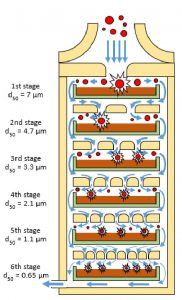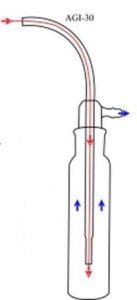1. Inquiry
The Homeland Defense and Security Information Analysis Center (HDIAC) received a technical inquiry (TI) from the Pentagon Force Protection Agency requesting additional information on equipment from this link on the BioCloud.
2. HDIAC Response
HDIAC conducted a literature search and review of the Defense Technical Information Center (DTIC) Research & Engineering (R&E) Gateway, performed an open-source search, sought assistance from their subject matter expert (SME) network, and contacted Kontrol Energy about their BioCloud device.
3. Literature Review
Multiple searches were completed in DTIC’s R&E Gateway under various phrasings such as “viral impactor,” “impactor sampling,” “aerosolized particle detection,” and “BioCloud.” Results for the first three terms yielded results in the hundreds; however, “BioCloud” returned zero results. An open-source search for information on similar keywords was also conducted, returning thousands of listings. Table 1 contains a list of articles pertaining to the types of technology used in aerosolized sampling for virus detection. Note that the technology used to produce the BioCloud by Kontrol Energy is likely proprietary, and there was no information in any of the literature reviewed during this TI.
Table 1 – Studies Pertaining to The Aerosol Virus Detection
| Title / Author(s) / Organization | Date Published/ Accession
No./ Distribution Statement |
| High Volume Air Sampling for Viral Aerosols: A Comparative Approach
Author(s): Cooper, Casey W. Org: AIR FORCE INST OF TECH WRIGHT-PATTERSON AFB OH GRADUATE SCHOOL OF ENGINEERING AND MANAGEMENT |
2010-03-01
ADA519642 A – Approved for Public Release |
| Studies on Aerosols
Author(s): Dautrebande, Lucien Org: ROCHESTER UNIV NY ATOMIC ENERGY PROJECT |
1958-10-01
CBRNIAC-CB-120094 E – DoD Only |
| Sensor Systems for Biological Agent Attacks: Protecting Buildings and Military Bases
Author(s): Killian, James, Meyer, Emily Ann, Chang, Julius, Dressen, Sharon, Eyring, Greg Org: NATIONAL RESEARCH COUNCIL WASHINGTON DC BOARD ON MANUFACTURING AND ENGINEERING DESIGN |
2004-01-01
ADA457006 A – Approved for Public Release |
| Evaluation of XMX/2L-MIL Virtual Impactor Performance and Capture and Retention of Aerosol Particles in Two Different Collection Media
Author: Black, Jon E. Org: AIR FORCE INST OF TECH WRIGHT-PATTERSON AFB OH SCHOOL OF ENGINEERING AND MANAGEMENT |
2011-03-01
ADA539055 A – Approved for Public Release |
| Proceedings of the First Joint Conference on Point Detection for Chemical and Biological Defense
Author(s): Not Available Org: Joint Science and Technology Panel on Chemical and Biological Defense |
2000-10-23-27
DAAD05-00-P-7443
A – Approved for Public Release |
The documents listed in Table 1 vary in their distribution statements and can be provided (as authorized by their distribution code) to holders of a .mil or .gov email address.
4. Research Analysis
Aerosolized (suspended in air) particles, in this case, COVID-19 particles, are detected by the BioCloud through its “inertial impact viral collider” as stated in the link provided [1]. However, it is unclear what specific sampling technology is used in this device. The information posted on Kontrol Energy’s website about the BioCloud says that a combination of three independent capture techniques is used for sampling COVID-19 particles, but it does not provides specifics as to which three. However, from the term “inertial impact viral collider,” it can be assumed that an impact sampling method is likely used. Common devices used when trying to recover airborne viruses (Figure 1) include liquid and solid impactors, filters, and electrostatic precipitators. The appropriate selection of sampling methods (based on the type of particle) is important, as particle size and properties influence effective capture which must drive the sampling method.

Figure 1 – Diagrams of six different bioaerosol samplers
4.1 Particle Size and Properties
A virus can only multiply within a host cell. These infected cells can spread directly into the surrounding air (primary aerosolization) or to fluids and surfaces, which also can become sources for transmission (secondary aerosolization) [2].
The aerodynamic diameter of an airborne particle (usually written as “d”) is crucial in determining how the particle will behave in the air, controlling how long it will hang in suspension and where it will deposit in the respiratory system if inhaled or ingested. Most particles larger than 10 μm will not pass through the upper airways, while smaller particles will travel farther towards the respiratory system [3, 4]. The reason size is important for particle detection is because virus sampling methods have a cut-off diameter. For example, should a particle of interest have a diameter of 2 μm and an inertial impactor sampling device with a cut-off diameter of 5 μm was chosen, every particle smaller than 5 μm would pass through the device. Thereby, the particle of interest (in this example, 2 μm) would go undetected.
Finally, properties of the particle’s makeup will affect the aerosolization. A particle sneezed into cold air may aggregate quickly and not pose a serious threat of transmission nor be detected, while the opposite may be said of some virus particles dispersed in a room with higher humidity.
It is important to understand that all virus particles have different characteristics, making it important to select the correct sampling method.
4.2 Sampling Methods
4.2.1 Solid Impactors
Solid impactors include Andersen samplers, slit samplers, and cyclone samplers; these are typically more reliable in capturing larger particles. In this technology, particles are accelerated through narrow holes or slits, guiding the airflow toward a solid surface while abruptly changing direction. The inertia of the particles separates them from the airflow and causes them to impact the capture medium, typically a petri dish [2]. A major benefit of the Andersen sampler, (Figure 2 [5]), is that it can be structured in multiple levels. In this design, each level is designed to capture particles of a particular aerodynamic size range, capturing smaller and smaller diameters as the airflow progresses and speeds up through the device.

Figure 2 – Andersen Impactor diagram
Slit samplers are tailored towards the detection of virus particles over time. In this case, accelerated particles impact a rotating petri dish containing a culture medium [2]. This function makes it possible to determine the time of when each particle was present and sampled.
A cyclone sampler consists of a circular chamber with an aerosol stream entering through one or more nozzles. Like other impactors, the cyclone depends upon the speed at which particles are traveling to be deposited on the sampler [6].
4.2.2 Liquid Impactors
Liquid impactors in the form of impingers, like AGI-30 (Figure 3) are the most commonly used for capturing airborne viruses. Liquid impactors use liquid mediums to save particles that have hydrophobic properties from reaerosolization [2]. The body of an impinger is filled with a collection liquid, and the aerosol stream flows down through a nozzle and enters the liquid at a high velocity. The particles are collected when they collide with the bottom of the collection vessel or disperse into the liquid [6]. Impingers also have a collection efficiency curve and cut-off diameter because they use inertia to accelerate particles down the nozzle; larger particles get stuck higher in the orifice as smaller particles make their way to the bottom [6].

Figure 3 – AGI – 30
4.2.3 Filters
Capturing particles with an aerodynamic diameter of <500 nm is difficult for the previously mentioned sampling methods; however, filters are able to capture these smaller particles but create complications for further analysis. Desiccation (removal of moisture) of the samples from filters can damage or interfere with the sample collection, potentially ruining the sample. Some filters work better than others; gelatin filters, for example, provide the most compatible conditions when particles <500 nm need to be sampled and extracted [2].
4.2.4 Electrostatic precipitators
Electrostatic precipitation is done through the use of a strong electric field, which creates a high concentration of unipolar ions (unipolar refers to charging in the presence of ions of only one polarity) [7]. The rapid motion of these ions causes them to collide with and charge airborne particles, and the resultant charge on the particles causes them to be attracted to the collection surface [6]. The effect of the charges makes the particles “rain down” on the sampling medium. The major upside to this sampling method is the amount of air that can be evaluated in a relatively short amount of time; however, charging the particles does increase the damage done to the virus cells themselves.
5. Conclusions
HDIAC analysts were unable to ascertain the technology used by the BioCloud device, likely due to the proprietary nature of the design. Queries to Kontrol Energy were not answered in time for inclusion in this report; should a response be received; this report will be updated. However, based on information provided in the product description, HDIAC analysts assumed that the BioCloud device used an impact collection system and provided a summary of the most commonly used inertial impaction methods for sampling aerosolized virus particles.
References
[1] Kontrol Energy Corp. [Online]. Available here. [Accessed 13 11 2020].
[2] D. Verreault. “Methods for Sampling of Airborne Viruses.” Microbiology and Molecular Biology Reviews, vol. 72, 2008.
[3] A. N. S. S. G. J. D. P. C. T. J. W. M. T. W. J. P. H. M. J. G. Urania Rappo. “Impact of Early Detection of Respiratory Viruses by Multiplex PCR Assay on Clinical Outcomes in Adult Patients.” Journal of Clinical Microbiology, vol. 54, no. 8, p. 8, 2016.
[4] K. Freeman. “The Efficacy of Expedient Mask Material.” Homeland Defense and Security Information Analysis Center Technical Inquiry Response Report, p. 8, 2020.
[5] A. AA. “New Sampler for the Collection, Sizing, and Enumeration of Viable Airborne Particles.” J. Bacteriol., vol. 76, no. 5, pp. 471-484, 1958.
[6] C. N. D. o. Health. “Sampling and Characterization of Bioaerosols.” NIOSH Manual of Analytical Methods (NMAM), vol. 5, p. 115, 2017.
[7] S. F. &. P. M. D.Y. H. Pui. “Unipolar Diffusion Charging of Ultrafine Aeroslos.” Aerosol Science and Technology, vol. 8, no. 2, pp. 173-187, 1988.


